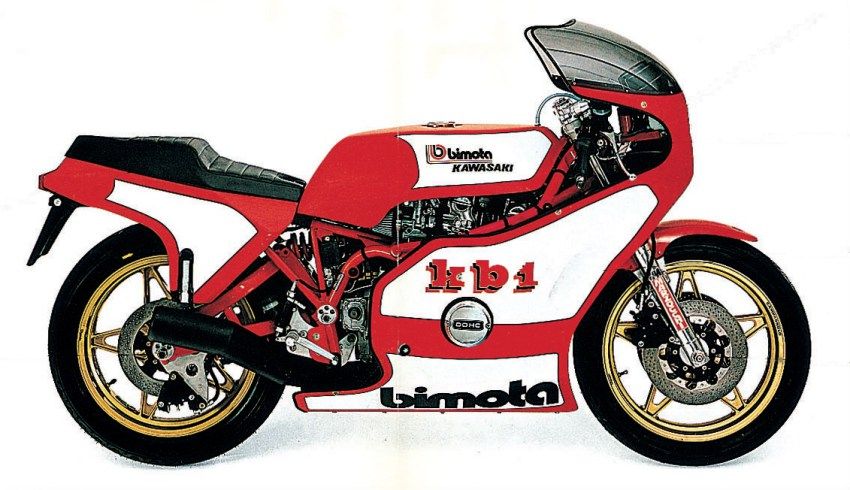On December 15, along with the new KB4, Kawasaki Motors Japan announced the handling of the Bimota brand in Japan. BIMOTA debuted the H2 supercharged engine, the Stage H2, in 2020, but this is the first time the new Bimota has officially arrived in Japan. We would like to explain the traditional brand that has become more familiar to the public through sales at Kawasaki Plaza and other stores.
BIMOTA is an Italian brand that develops and produces everything except engines.
BIMOTA was founded in 1966 as an air conditioning company, and the company name was named after the initials of each of the three founders. In 1973, the company began working as a motorcycle frame builder, led by TA Tamburini, one of the founders, and released its first mass-produced model, the HB1, in 1975.
In the 1980s, the company won the TT-F1 World Championship, the forerunner of the current World Superbike Championship, and in 1990, it introduced the first model with a front hub steering system. In 1990, the company introduced the first model with a front hub steering system, making its name known around the world.
BIMOTA's production method is unique. Unlike Kawasaki's line production, each motorcycle is hand-assembled from the ground up, demonstrating the kind of craftsmanship that only Italy can offer. Even the paint is applied by hand, one by one, to ensure that each motorcycle is unique.
The combination of Kawasaki's engine and this new motorcycle is expected to create new value: handmade Italian design, high performance and high reliability.
In 2019, the new Bimota, which began full-scale activities after Kawasaki Motors Group took a stake in the company, released the Tage H2 with the H2's supercharged engine in 2020. Kawasaki Motors Japan President Kirino is also active in the sales of the Tage H2 and will consider establishing a sales structure in the future.

The new Bimota, which began full-scale activities in 2019 when Kawasaki Motors Group took a stake in the company, released the Tage H2 in 2020, powered by the H2's supercharged engine. The president of Kawasaki Motors Japan, Mr. Kirino, is also very positive about the sales of the Tage H2 and will consider establishing a sales structure for it.

The KB4, which made its Japanese debut on December 15, uses the same 1043cc parallel four-cylinder and electronic control set-up as the Kawasaki Ninja 1000SX. The KB4 is the fourth Kawasaki engine model, and the first new model in 40 years since the 1983 KB3. The new model will be available at about 50 Kawasaki Plaza stores and BIMOTA dealers. The price is 4,378,000 yen.
BIMOTA and Kawasaki collaborate on the KB Series, a history of parallel four-cylinder engines
In 1978, the KB1, the first BIMOTA to be powered by a Kawasaki engine (Z900/Z1000), was born; in 1981, the KB2 was a full-fledged racing machine powered by a 550cc Kawasaki engine (such as the Z550FX) and designed to compete in the former TT-F2 class; in 1983, the KB3 was a street-sport model powered by the Z1000J engine. In 1983, the KB3 was a street sports model that used the Z1000J engine.
With the KB series, Bimota's goal was to take something that already had a high level of performance and take it to the next level. By combining Kawasaki's high-performance engine with a more nimble chassis, Bimota was able to sharpen the machine's inherent athleticism.
The new KB4 features the same "liquid red" chassis as the previous KB series, and a "vintage inspired" design inspired by the original KB1. Forty years later, the KB4 still retains the original KB series philosophy, with a Kawasaki in-line four-cylinder engine, mass centralisation, a low riding position and a unique cooling system.

The 1978 KB1 used the same air-cooled straight-four engine as the Z900 and Z1000, the successors to the Kawasaki Z1. At a time when the only Japanese models available were the bikini cowls of the Z1-R and other models, the racer-like full cowl and clip-on handlebar were just too special.

In 1976, the Z1000 was redesigned as the Z900 to improve reliability, and in 1977, the displacement was increased by 4mm to 1015cc. The photo shows a 1978 model, the same year as the KB1.

This model was developed based on the engine of the middle class Z550 series (Z400FX in Japan), and has a beautiful trellis frame that is considered to be one of the best.

In 1979, Kawasaki developed DOHC 400cc and 500cc engines and launched the Z400FX and Z500 in Japan and overseas. 500cc version was expanded to 553cc in 1980. The photo shows the 1981 GPZ550, the same model as the KB2.

The 1983 KB3 was based on the newly designed Z1000J engine, and differed from previous models in that it was mounted on a general-purpose chassis that could accommodate parallel four-cylinder engines from various manufacturers.

In 1981, Kawasaki released the Z1000J, which featured a completely new engine design from the previous Z1 series. At the same time, an 1100 version, the GPZ1100, was also available, and the Z1000J was a sports version designed for racing.
KB0 if you want to count it? That kit part custom for the phantom Z1 is so cool!
In fact, the collaboration between BIMOTA and Kawasaki began even before the 1978 KB1, with the BIMOTA Z1 kit that many people know about.
In 1973, BIMOTA sold swingarm, magnesium wheels, seat & exterior for Z1. It is not numbered, probably because the frame was not produced, but it was before the 1978 KB1, so it should be called the "KB0".
At the KB4 launch on December 15, BIMOTA representative Pierluigi Marconi said, "We will continue to develop the Z1000RS using the same 1043cc parallel four-cylinder engine used in the KB4. At the KB4 launch on December 15, Bimota representative Pierluigi Marconi said, "We will continue to develop the Z1000RS using the same 1043cc in-line four-cylinder engine used in the KB4."

The Z1 was fitted with kit parts released by BIMOTA in 1973, and the cafe racer style looks pretty cool even today.

The Z1 started shipping in the fall of 1972 and will officially celebrate its 50th anniversary in 2022. 2023 will be the 50th anniversary of the Bimota x Kawasaki collaboration if you count KB0, so it's the perfect time to release a custom version!




